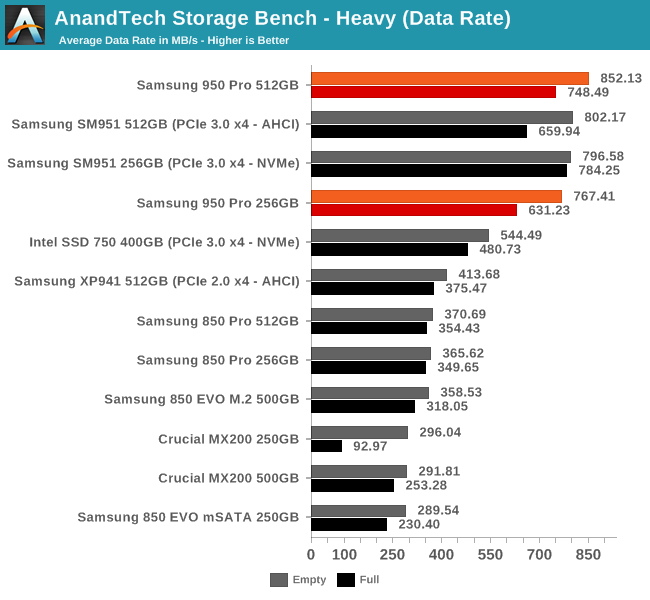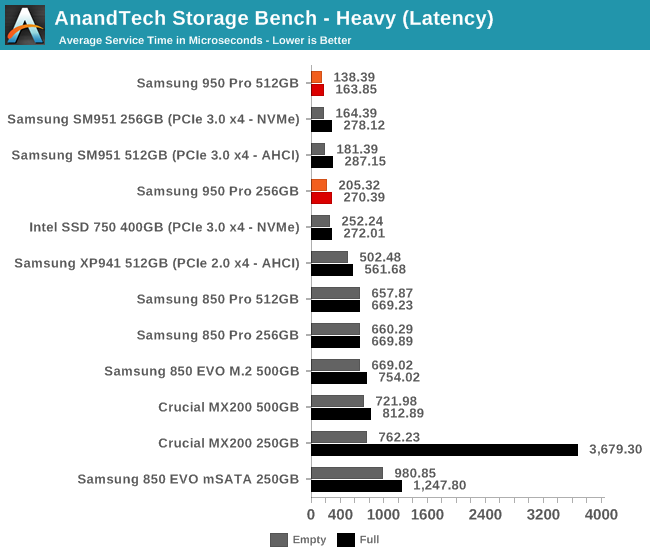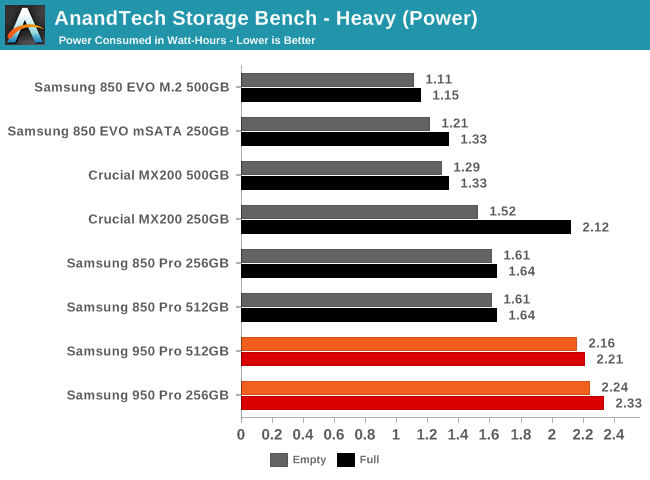The Samsung 950 Pro PCIe SSD Review (256GB and 512GB)
by Billy Tallis on October 22, 2015 10:55 AM ESTAnandTech Storage Bench - Heavy
Our Heavy storage benchmark is proportionately more write-heavy than The Destroyer, but much shorter overall. The total writes in the Heavy test aren't enough to fill the drive, so performance never drops down to the steady state. This test is far more representative of a power user's day to day usage, and is heavily influenced by the drive's peak performance. The Heavy workload test details can be found here.

Performance of the 950 Pro is comparable to the SM951, which is to say that it's significantly better than everything else we've tested. The penalty when starting with a fill drive is a bit larger than normal, but simply being full isn't enough to tank the performance the way a sustained test can.


Average service time and latency outliers are vastly better than any SATA drive, but NVMe doesn't seem to make a huge difference.

The high performance comes with the price of high power consumption, and the total energy used over the course of this test is significantly higher than all the high-performance SATA drives we're comparing against.










142 Comments
View All Comments
bill.rookard - Sunday, October 25, 2015 - link
VERY interesting. Of particular note is the Crucial MX200 - an older drive, and connected via SATA which trades blows back and forth with the newer PCIe - nvme based drives. Wow, good stuff.Deders - Thursday, October 22, 2015 - link
I think it was only PCIe drives that had long booting times like the Intel 750.Gigaplex - Thursday, October 22, 2015 - link
These are PCIe drives.Deders - Friday, October 23, 2015 - link
I mean slotted drives as the drive controller has to load from the deviceKristian Vättö - Thursday, October 22, 2015 - link
I have a 256GB 950 PRO in my system (AsRock Z170 Extreme 7) and boot time is about 8 seconds with ultra fast boot enabled in BIOS/UEFI.Jacerie - Thursday, October 22, 2015 - link
Why would you go on about how awesome Skylake and the 100 series chipset are for PCIe connected drives and then use a Haswell chip and a Z97 board for the test rig? Time to go back to the bench.Billy Tallis - Thursday, October 22, 2015 - link
The Haswell system is what I've got on hand to test with, and it's what allows my results to be directly comparable with the reviews from earlier this year.Skylake gives you PCIe 3 from the PCH, but on the testbed we always use an x16 slot directly off the CPU for PCIe SSDs, so we don't need Skylake to run the drive at PCIe 3 speeds.
Jacerie - Thursday, October 22, 2015 - link
Will you be posting a follow-up to highlight any controller differences with the newer hardware?MrSpadge - Thursday, October 22, 2015 - link
This is not a SATA controller we're talking about, it's PCIe. And there we have hardly seen any differences between different implementations over the years.hansmuff - Thursday, October 22, 2015 - link
May I humbly request an addition to the review to show performance AND issues when using a PCI Express 2.0 to M.2 adapter on an older platform like the P67A?